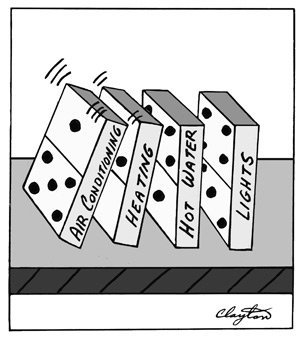|
The Domino EffectThe domino effect is a side effect of a behavior. In other words, one behavior frequently leads to the same behavior in other areas as a natural side effect. Behaviors are interrelated. For example, when a person is consciously conservative in one area of his or her life, he or she frequently becomes conservative in other areas as well. An example of this effect can be observed when conserving electricity. By deciding to adjust the thermostat a few degrees to conserve energy (heating and cooling are some of the highest energy users), a person frequently starts exhibiting the same conservative behavior with other lesser important energy sources. He or she may take less hot showers, turn off lights when leaving a room, and shut off the computer and television when they aren’t being used. These are all common side effects. Many times this occurs without thinking. A conservative behavior mentality leads to more conservation behaviors.
The Backfiring Danger The domino type of effect can backfire if one isn’t careful. For example, if a person is usually financially conservative and then spends significantly over his budget when buying a car, a spending mentality can creep in.He may start going out to more expensive restaurants for dinner, pay less attention to where money is being spent and so forth. Busting of the budget on a big ticket item can lead to thoughts of “why bother.” Reckless spending habits can be a side effect. In Summary: The habits that we choose (consciously and unconsciously) effect our behavior in more ways than may be realized. The domino effect can magnify (good or bad) behaviors. These behavior effects are powerful. Becoming aware of them and using them to your advantage can be beneficial.
Do you want to unlock the power of critical thinking and create an amazing future? If so, click the link and get your copy of Mastering Critical Thinking today! |


